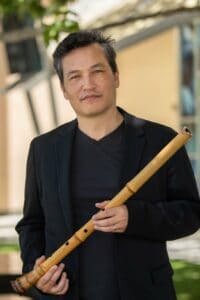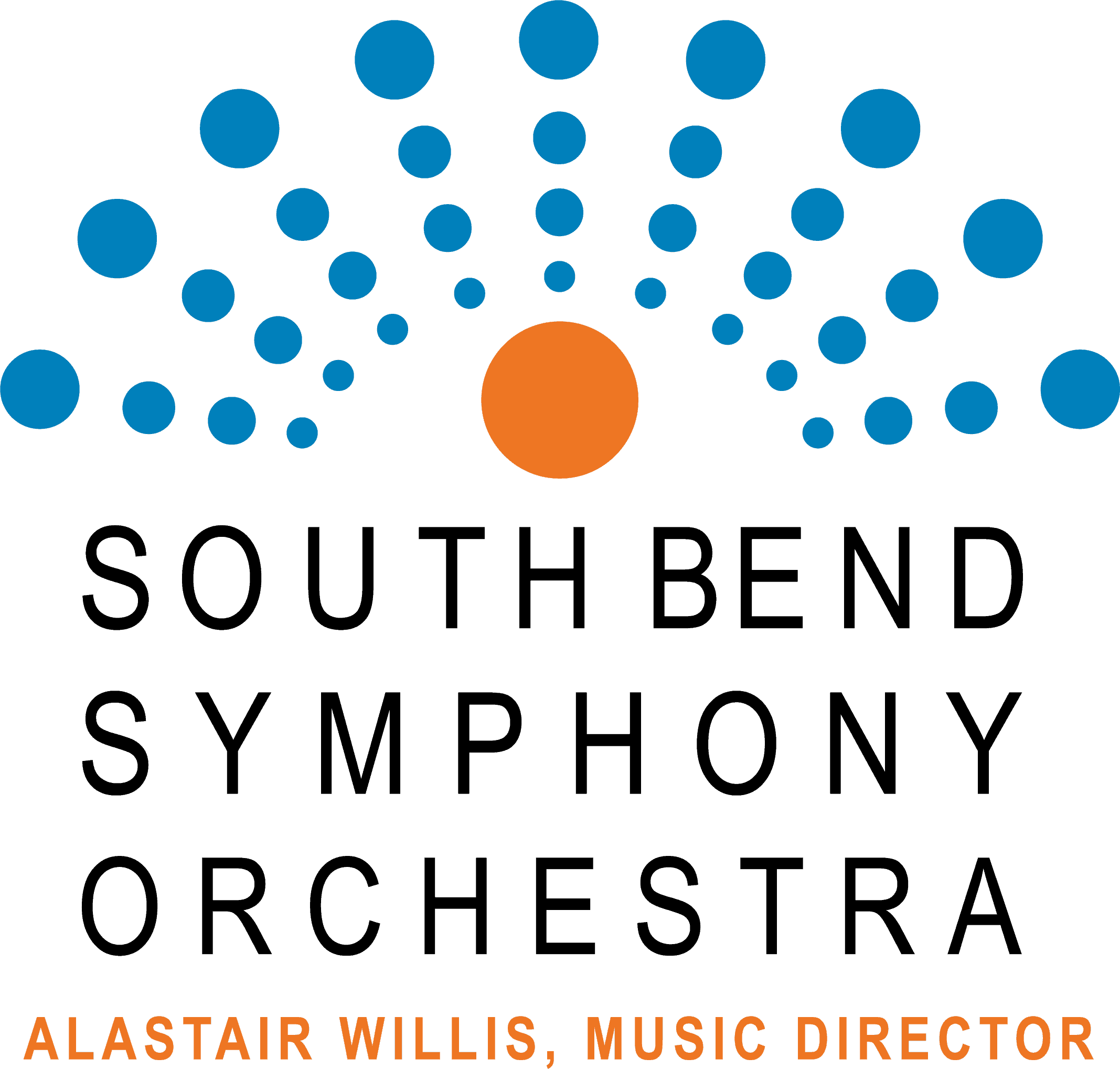January 12, 2025 / 2:30 p.m.
Experience the timeless beauty of Copland’s iconic masterpiece, Appalachian Spring, as it vividly portrays the American landscape. Kojiro Umezaki joins the Symphony as he uses the shakuhachi to transform the landscape imagined in Angel Lam’s Empty Mountain, Spirit Rain, and Takuma Itoh’s Faded Aura.
Program
KOJIRO UMEZAKI
(Cycles) What Falls Must Rise
ANGEL LAM
Empty Mountain, Spirit Rain
I. Silent Field
II. Rain
TAKUMA ITOH
Faded Aura
COPLAND
Appalachian Spring
I. Very Slowly
II. Allegro
III. Moderato
IV. Quite Fast
V. Subito Allegro
VI. Meno Mosso
VII. Doppio movimento
VIII. Coda. Moderato
Program Notes
(Cycles) What Falls Must Rise
KOJIRO UMEZAKI
Born: 1968, Tokyo, Japan
Composed: 2009 Premiered: 2009, Dartmouth College, Hanover, New Hampshire
Duration: 13 –14 minutes
As the reference to cycles in the title suggests, the setup for this piece is one of perpetually constrained motion with high and low points, which, on the surface, seems antithetical to notions of enlightenment and transcendence. Nevertheless, in the original work commissioned in 2009 by the Hopkins Center for the Arts at Dartmouth College and written for shakuhachi and the ground-breaking string quartet Brooklyn Rider, a descent inspired by the “Sagariha” melody is followed by modes and rhythms lying somewhere between the foreign and familiar, ascending in energy only to arrive back again at the top, ready for the inevitable next iteration of falling and rising again. This 2024 arrangement of Cycles: What Falls Must Rise for orchestra starts somewhere in the cycle and ends elsewhere, the exact points to be revealed in the performance. – Kojiro Umezaki, 2024
Empty Mountain, Spirit Rain
ANGEL LAM
Born: August 2, 1978, Hong Kong
Composed: 2006
Premiered: 2006, Carnegie Hall, New York, New York
Duration: 13-14 minutes
Angel Lam, New York-based Hong Kongborn composer, has composed for artists and ensembles such as Yo-Yo Ma, Aldo Parisot, The Silk Road Ensemble, and many others. She shares, “This piece is dedicated to a childhood memory of my grandmother and the sceneries of the place where I grew up. Thirty minutes had passed, but my grandma still hadn’t arrived to pick me up. My kindergarten sat atop a lush green hill overlooking a muddy pedestrian sidewalk alongside traffic. Kojiro Umezaki It was another humid summer day; the aggressive sun seemed to slow down my time but activated the scenery in front of me. Trees moved in the heat like monsters stretching their palms…pedestrians were dragged down by their long, bony shadows. Suddenly, it rained, but the sun still shone. I decided to run home. I was only five years old. I sprinted down that bustling traffic street, my teachers shouted after me like low-pitched murmurings of ancient emperors. The sound of horns screamed sharply with long mystic tails… When a distant temple bell drummed, I saw Grandma—her peaceful smile and an air of gracefulness that is memorable to this day. This time, she seemed bigger. When I reached out to touch her, she f loated through me…I turned around, and the sun shone directly into my eyes. Grandma disappeared into the core of the afternoon sun. The evening sun suddenly closed, and the rain stopped. When I got home, everybody was crying. But I did not cry. I went to my writing desk and started a letter: Dear Grandma…” – Angel Lam, 2024
Faded Aura
TAKUMA ITOH
Composed: 2017
Born: 1984, Japan
Premiered: Nov. 11, 2017,
Peabody Essex Museum, Salem, Massachusetts Duration: 8 minutes This work delves into creating a musical “halo” around the rich tones of the solo shakuhachi through sound color and harmony. The virtuosity and beauty of the shakuhachi lie in the player’s ability to extract so much from a single tone – vast gradations of vibrato, subtle shifts in dynamics, and varying levels of breathiness and air. Initially written for Kojiro Umezaki and the innovative new music quartet Hub New Music, the piece transforms the entire orchestra into a “super-shakuhachi.” Each musician contributes to a unified sound, savoring the color of each note just as a solo shakuhachi player would, but with more exaggeration and creative license. This new arrangement for a chamber orchestra further expands this concept, with additional instruments enhancing the aura around the shakuhachi, creating an even more immersive experience. – Takuma Itoh, 2024
Appalachian Spring
AARON COPLAND
Born: November 14, 1900 New York, New York
Died: December 2, 1990 North Tarrytown, New York
Composed: 1943-1944
Premiered: October 30, 1944, Coolidge Auditorium, Washington, DC
Duration: 24 minutes
Following the resounding success of Billy the Kid (1938) and Rodeo (1942), Aaron Copland eagerly embraced another ballet commission from visionary choreographer Martha Graham in late 1942. At the pinnacle of their respective careers, both artists embarked on a collaboration that would redefine artistic expression. Their partnership was not just destined for greatness but for profound artistic resonance. At its premiere on October 30, 1944, Appalachian Spring received high praise, with critic John Martin noting its “very moving sense of the future” and “fine and simple idealism.”
Appalachian Spring is often considered Copland’s seminal work. It solidified his reputation among 20th-century composers and established a uniquely “American” sound. This sound, primarily attributed to his use of folk music, is best exemplified in the most famous passage, derived from the Shaker tune “Simple Gifts,” featured in movement seven. However, aside from this melody, most of the music is original yet distinctly American.
The original ballet had 14 segments; the orchestral version eight. The composer kindly provided the following road map:
1. Very slowly. Introduction of the characters, one by one, in a suffused light.
2. Fast. Sudden burst of unison strings in A Major arpeggios starts the action. A sentiment both elated and religious gives the keynote to this scene.
3. Moderate. Duo for the Bride and her Intended — scene of tenderness and passion.
4. Quite fast. The Revivalist and his flock. Folksy feeling — suggestions of square dances and country fiddlers.
5. Still faster. Solo dance of the Bride — presentiment of motherhood. Extremes of joy, fear, and wonder.
6. Very slowly (as at first). Transition scene to music reminiscent of the introduction.
7. Calm and flowing. Scenes of daily activity for the Bride and her Farmer husband. There are five variations on a Shaker theme. The theme, sung by a solo clarinet, was taken from a collection of Shaker melodies compiled by author Edward D. Andrews, and published under the title “The Gift to Be Simple.” The melody most borrowed and used almost literally is called “Simple Gifts.”
8. Moderate. Coda. The Bride takes her place among her neighbors. At the end the couple are left “quiet and strong in their new house.” Muted strings intone a hushed prayer like chorale passage. The close is reminiscent of the opening.
Kojiro Umezaki, Shakuhachi

Noted by The New York Times as a “virtuosic, deeply expressive shakuhachi player and composer” and the LA Times as one of the “better kept secrets of Southern California music,” Kojiro Umezaki (梅崎康二郎) has performed regularly with the Silkroad Ensemble since 2001. He appears on the Grammy Award winning album Sing Me Home, A Playlist Without Borders, Off the Map, and the Grammy-nominated 2015 documentary film, The Music of Strangers, directed by Morgan Neville. In a Circle Records released (Cycles), an album of original work, in 2014, and 流芳 Flow, a duo album with Wu Man, in 2021. A new collaborative album with Hub New Music—a distance, intertwined—will be released by In a Circle Records on Friday June 7, 2024. Other notable recordings as performer, composer, and/or producer include Brooklyn Rider’s Dominant Curve, Nicole Mitchell’s Mandorla Awakening II, Kei Akagi’s Aqua Puzzle, and Huun Huur Tu’s Ancestors Call. Born to a Japanese father and Danish mother, Umezaki grew up in Tokyo, and continues to explore global and hybrid practices in music.
Meet the Musicians Here!
Secure your seat with a Season subscription. Visit www.southbendsymphony.org or call 574-232-6343 to save your seats and get the best prices!
Sponsors


